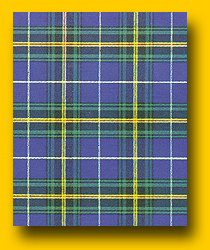 In 1953 one of Nova Scotia's talented home weavers, Mrs. Bessie Murray, designed a tartan in response to a province-wide request from the Nova Scotia Sheep Association for examples of the many ways local wool could be used. Originally intended only for display at the agricultural exhibition in Truro, Mrs. Murray's design so captured the imagination of Nova Scotians that it was adopted as the Provincial Tartan by an Order in Council in 1955, making it the first provincial tartan in Canada. The following year the Tartan was submitted to the Court of the Lord Lyon King of Arms, and was registered with Her Majesty's Register Office in Edinburgh, Scotland. In 1964 the House of Assembly passed the Tartan Act which describes the design and outlines how it is to be manufactured and used.
In 1953 one of Nova Scotia's talented home weavers, Mrs. Bessie Murray, designed a tartan in response to a province-wide request from the Nova Scotia Sheep Association for examples of the many ways local wool could be used. Originally intended only for display at the agricultural exhibition in Truro, Mrs. Murray's design so captured the imagination of Nova Scotians that it was adopted as the Provincial Tartan by an Order in Council in 1955, making it the first provincial tartan in Canada. The following year the Tartan was submitted to the Court of the Lord Lyon King of Arms, and was registered with Her Majesty's Register Office in Edinburgh, Scotland. In 1964 the House of Assembly passed the Tartan Act which describes the design and outlines how it is to be manufactured and used.
As a note of interest, the Lord Lyon King of Arms is the Scottish official empowered to regulate heraldry in that country, to oversee state ceremony in Scotland, to grant new arms to persons or organizations, and to confirm or deny pedigrees and claims to existing arms. That officer is the judge of the oldest functioning Heraldic court in the world.
The Nova Scotia Tartan does not represent a Clan; it can be worn by anyone. In the design blue denotes the ever-present sea; white is the colour of the foaming waves and granite shore. Green recalls "the forest primeval" of Acadia. The Province's historic Royal Charter is represented by twin bands of gold enclosing a red line honouring the royal lion rampant found on the Nova Scotia Coat of Arms.
The Tartan has been designated the official dress attire for Festival 2010. It is recognized, though, that many dancers already wear different versions of the basic pattern. A specific Festival Dress has, therefore, not been defined; designs are left up to individuals. So get out your Nova Scotia Tartan plaids to alter, mend, sew and fashion new outfits!